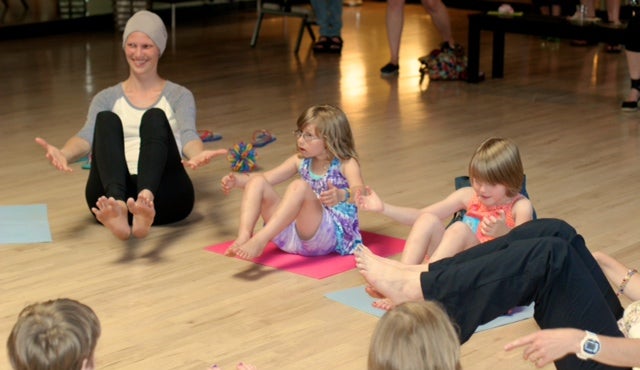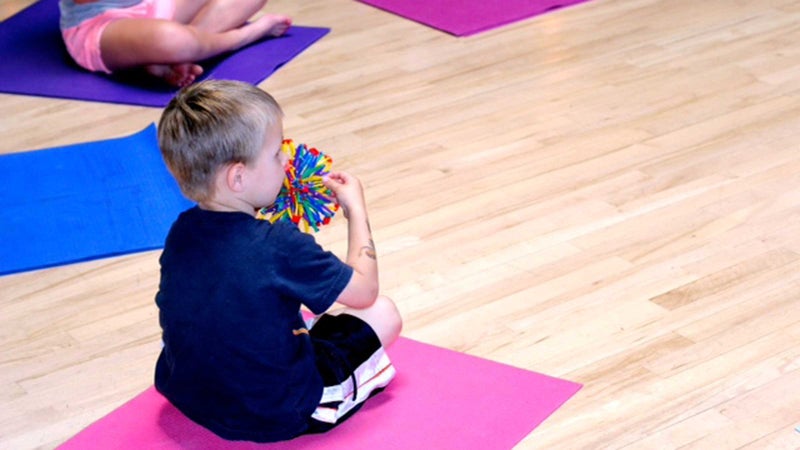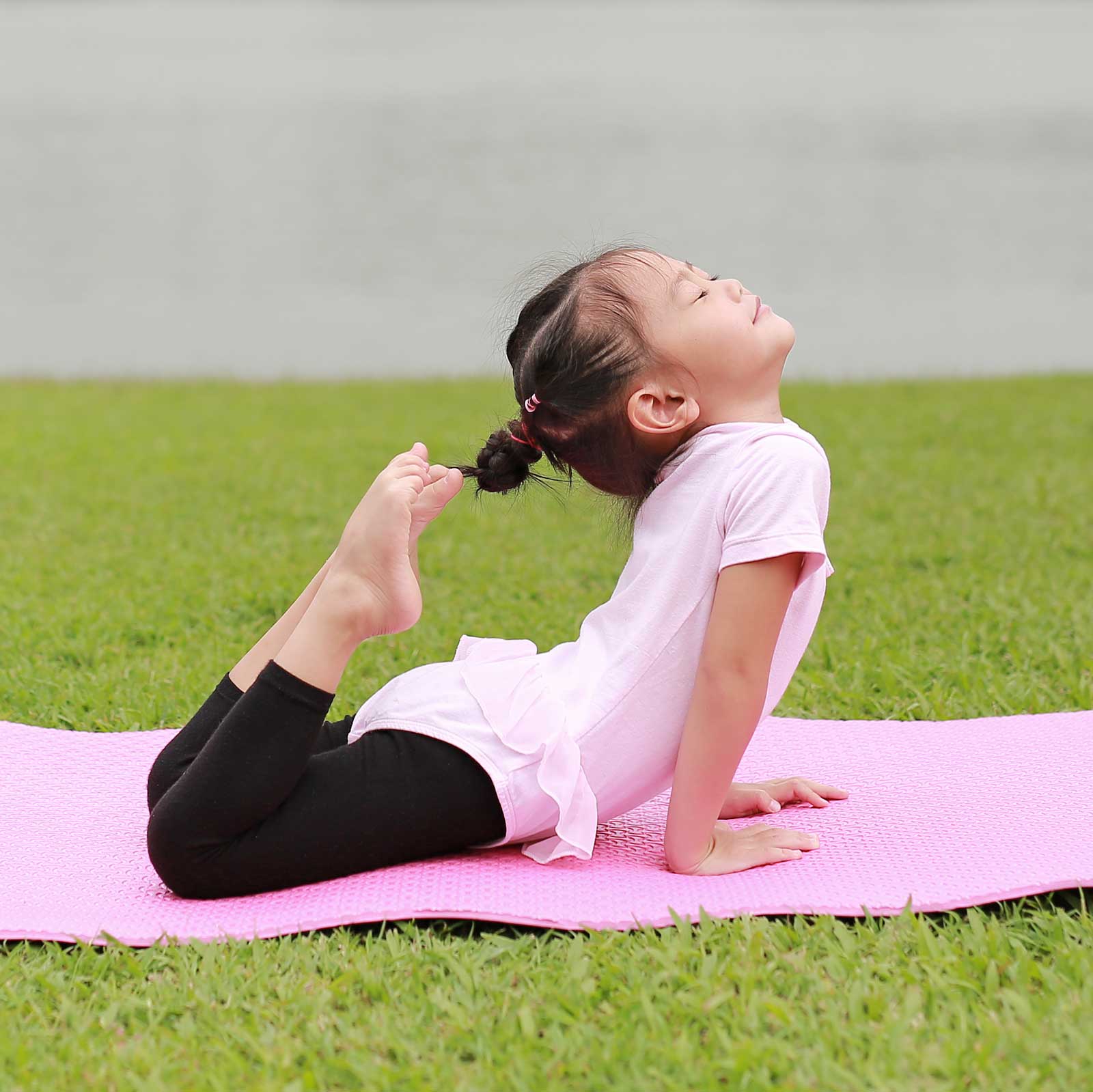As a child of the '70s I was stuck between my older sister’s Jane Fonda leotard workouts and my mom’s obsession with the yoga revolution that was sweeping the country. I alternated between doing aerobics in front of her full-length mirror and sitting on the carpeted floor, legs folded, arms twisted like an elephant’s trunk, eyes closed, breathing deeply. Even at age four, I remember yoga making me feel strong, calm, and connected.
Three decades later, yoga for kids is booming, with classes for children as young as three. Proponents say it’s a way for little ones to deal with the pressures of childhood. It also helps give them focus and flexibility that can benefit them in sports and school. But as a parent of four active, soccer-playing, hiking, skiing, outdoor boys, I was on the fence: Do kids really need yoga? Or is it just another activity to add to their overly-scheduled lives?
I decided to find out. My five-year-old had done a little yoga in nursery school and was excited about it, so I found a kids’ class not far from our house in St. Paul. In the first class, he did every pose the teacher asked and cruised through the hour. He spent the second class saying things like, “Oops, the fruit fell off my table,” whenever he fell out of his hands and knees in table top position. Or in “lower pose, where his hands laced under his knees, as he sat crosslegged, he would say, “Someone just picked me,” when he lost his grip. I have to admit I found this funny, even kind of yogic. He could laugh at himself.
His teacher did not. She told me she didn’t think he was ready for yoga. When I asked why, she said, “Because he couldn’t hold his poses for the length of time required.” Since when can a wiggly five-year-old sit still for longer than 20 seconds much less hold a pose? We decided to take a break. When I saw her again, the teacher said, “Well, the class is much calmer without him.”

Convinced that yoga had done me some good as a child, and determined to not let one sour experience leave a bad taste in my boy’s mouth, I kept looking. Surely there had to be a class that taught relaxation techniques without stifling his little kid enthusiasm. Turns out there is: . Designed specifically for pre-K kids through high school students, the nationally-accredited technique encourages focus, stillness, listening skills, and community through a mix of simple postures, games, and breathing techniques. Rather than the focus being on holding poses, play and movement are cornerstones of Yoga Calm. This leads to a less rigid, more compassionate approach, which needless to say was welcomed after our previous experience.
“So many pressures are piled up on kids—lack of sleep, poor nutrition, stress, electronic media,” says St. Paul–based preschool Yoga Calm teacher Chrissy Mignonga. “Yoga is a way to help kids slow down and learn healthy coping skills during the school day that they can then use at home, with peers, really everywhere. Yoga Calm uses yoga to get kids moving, breathing to help them self-regulate, games to help them identify emotions and become more socially adept, and relaxation techniques to manage stress.”
New York City Public Schools have incorporated yoga into their curriculum through a program called . And schools across the nation use Yoga Calm to ease transitions from recess to the classroom and the classroom to the specialist subjects. Teachers will ask kids to stand in their strong mountain poses as they wait in line, or have them come in from recess, breathe deeply and do a few yoga poses to calm down enough to redirect their energies to academic learning. Some schools incorporate it into their individual education plans for special education.
“If children learn these skills when they’re young, they will bring a deeper practice into the world as they get older,” says Yoga Calm founder Lynea Gillen, who created the program in 2002. “Young people are stretching the boundaries, practicing yoga on slack lines, on rock walls, and on mountaintops. One teacher recently taught a class on paddleboards in the water. It brings a sense of play and adventure to the practice.”
Could yoga be the antidote for long days of sedentary, indoor learning? Nothing replaces exploring nature or pushing physical limits outside. But when my boys hike the trails of New Mexico or run the wooded paths of the Midwest, their breath regulates, their gaze is strong and steady, their pulse quickens with exhilaration and then calms to contented happiness when we’re done. When I watch my boys and their friends do yoga, their breath regulates, and their pulse calms. Remarkably similar outcomes.

I recently took a three-day Yoga Calm instructor workshop, if for no other reason than to try and corral my four boys into a state of calm, and since then we’ve started doing a simple bed-time sequence each night. We do mountain pose for grounding and strength; woodchopper, in which we name and let go the frustrations from the day; volcano breath, to send something positive out into the world; and, of course, corpse pose. I’d like to say they fall asleep more easily and sleep more deeply—sometimes they do, sometimes they don’t. But they do seem more settled, more aware of their relaxed bodies, and aware of what one another has been through during the day.
Children are naturally better than adults are at living in the moment, but sometimes they move so fast it’s hard to tell. Yoga—as long as it’s not too structured —can help them slow down and, well, be kids. “It teaches them to become deeply connected to their body and make better choices when they pay attention to the bodies cues,” says Yoga Calm instructor Kathy Flaminio. “They learn how to be more present and mindful in their lives, which most often leads to respecting others and the earth.”
My seven-year-old gives me all the incentive I need to continue: “I feel good after yoga.” Hearing that, so do I.
For more info on classes in your area, great yoga postures for active kids, and tips for teaching kids how to meditate, check out and .��
Writer Elizabeth Sullivan has crisscrossed the country with her four boys, two dogs, and husband, and currently lives in her hometown of St. Paul, Minnesota.

